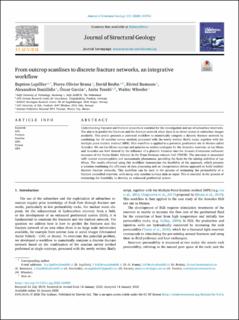| dc.contributor.author | Lepillier, Baptiste | |
| dc.contributor.author | Bruna, Pierre-Olivier | |
| dc.contributor.author | Bruhn, David | |
| dc.contributor.author | Bastesen, Eivind | |
| dc.contributor.author | Daniilidis, Alexandros | |
| dc.contributor.author | Garcia, Óscar | |
| dc.contributor.author | Torabi, Anita | |
| dc.contributor.author | Wheeler, Walter H | |
| dc.date.accessioned | 2021-02-17T14:27:57Z | |
| dc.date.available | 2021-02-17T14:27:57Z | |
| dc.date.created | 2021-02-15T12:22:40Z | |
| dc.date.issued | 2020 | |
| dc.identifier.citation | Journal of Structural Geology. 2020, 133 1-16. | en_US |
| dc.identifier.issn | 0191-8141 | |
| dc.identifier.uri | https://hdl.handle.net/11250/2728731 | |
| dc.description.abstract | Understanding fractures and fracture networks is essential for the investigation and use of subsurface reservoirs. The aim is to predict the fractures and the fracture network when there is no direct access to subsurface images available. This article presents a universal workflow to numerically compute a discrete fracture network by combining the 1D scanline survey method, processed with the newly written SkaPy script, together with the multiple point statistic method (MPS). This workflow is applied to a potential geothermal site in Mexico called Acoculco. We use Las Minas outcrops and quarries as surface analogues for the Acoculco reservoir, as Las Minas and Acoculco are both formed by the influence of a plutonic intrusion into the Jurassic–Cretaceous carbonate sequence of the Sierra Madre Oriental in the Trans-Mexican volcanic belt (TMVB). The intrusion is associated with contact metamorphism and metasomatic phenomena, providing the basis for the mining activities at Las Minas. The results obtained using this workflow demonstrate the feasibility of the approach, which presents a solution combining the efficiency of data processing and an interpretation-driven approach to build realistic discrete fracture networks. This workflow can be used in the process of estimating the permeability of a fracture controlled reservoir, with using only scanline surveys data as input. This is essential in the process of evaluating the feasibility to develop an enhanced geothermal system. | en_US |
| dc.language.iso | eng | en_US |
| dc.rights | Navngivelse 4.0 Internasjonal | * |
| dc.rights.uri | http://creativecommons.org/licenses/by/4.0/deed.no | * |
| dc.title | From outcrop scanlines to discrete fracture networks, an integrative workflow | en_US |
| dc.type | Journal article | en_US |
| dc.type | Peer reviewed | en_US |
| dc.rights.holder | © 2020, Authors | |
| dc.description.version | publishedVersion | en_US |
| cristin.ispublished | true | |
| cristin.fulltext | original | |
| cristin.qualitycode | 2 | |
| dc.identifier.doi | 10.1016/j.jsg.2020.103992 | |
| dc.identifier.cristin | 1889857 | |
| dc.source.journal | Journal of Structural Geology | en_US |
| dc.source.volume | 133 | en_US |
| dc.source.pagenumber | 1-16 | en_US |

